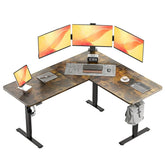Is a Standing Desk the Right Upgrade for Your Audio Engineering Studio? Key Factors to Consider.
You've been exploring the buzz around standing desks and, as a discerning audio engineer, you're likely weighing the potential benefits against the practical realities of your demanding profession. You understand the toll that prolonged hours in the studio can take on your body, and the idea of a more dynamic workspace is appealing. But before making a significant investment in your audio engineering setup, it's crucial to evaluate whether a standing desk is truly the right fit for your specific needs and workflow.
This in-depth guide is designed to help audio engineers like you make an informed decision. We'll delve into the critical factors to consider when evaluating standing desks for your audio engineering studio, moving beyond the general advantages to focus on the specific requirements and potential challenges within your unique environment. By carefully considering these aspects, you can determine if a standing desk will genuinely enhance your comfort, productivity, and the quality of your audio work.

Key Evaluation Points for Audio Engineers Considering Standing Desks:
Before you commit to a standing desk, thoroughly assess how it will integrate with your existing audio engineering setup and address your specific needs:
-
Stability is Paramount for Audio Equipment: Unlike a typical office environment, your audio engineering studio likely houses sensitive and often heavy equipment: studio monitors, mixing consoles, MIDI controllers, and various interfaces. A standing desk for an audio engineer must be exceptionally stable at all height levels. Any wobble or vibration can negatively impact the accuracy of your critical listening environment and potentially damage delicate gear. Look for standing desks with robust, heavy-duty frames (preferably steel) and a high weight capacity. Research reviews specifically from users in creative fields who rely on stable workstations.
-
Desktop Space and Configuration for Your Workflow: Consider the real estate required for your current audio engineering setup. Do you utilize a large-format mixing console, multiple monitors, extensive outboard gear, or a combination thereof? Ensure that the standing desk you're evaluating offers sufficient desktop width and depth to comfortably accommodate all your essential equipment in both seated and standing positions. Think about cable routing and whether the desk provides adequate space for tidy and accessible connections for all your audio gear.
-
Height Adjustment Range and Motor Quality: The ability to seamlessly transition between sitting and standing is a core benefit of a standing desk. Evaluate the height adjustment range of the models you're considering to ensure they comfortably accommodate your preferred seated and standing heights. Pay close attention to the quality and noise level of the electric motor. A jerky or loud motor can be disruptive to your creative flow and even be picked up by sensitive microphones during recording sessions. Look for standing desks that advertise smooth and quiet operation, crucial for a focused audio engineering environment.
-
Integration with Existing Studio Furniture and Acoustics: Consider how a standing desk will integrate with your existing studio furniture, including monitor stands, acoustic treatment, and seating options. Will the new desk height affect your monitor placement and the carefully calibrated acoustics of your audio engineering space? You might need to invest in adjustable monitor stands or make other adjustments to maintain an optimal listening environment in both seated and standing positions.
-
Your Specific Workflow and Task Breakdown: Analyze how you typically spend your time in your audio engineering studio. Are there specific tasks, such as detailed editing or intricate mixing, where a seated position offers greater precision and control? Conversely, are there phases like tracking or creative sound design where standing might feel more natural and energizing? Understanding your workflow will help you determine how frequently you'll likely transition between sitting and standing and which features of a standing desk will be most beneficial for your audio engineering practice.
-
Budget and Long-Term Value: While price is always a consideration, prioritize quality and stability over the cheapest option. A well-built standing desk is an investment in your health and productivity as an audio engineer. Consider the long-term value and durability of the desk, as well as the warranty and customer support offered by the manufacturer. A poorly constructed standing desk that wobbles or malfunctions will ultimately hinder your audio engineering work and could end up being a false economy.

Making the Informed Choice for Your Audio Engineering Studio:
Carefully considering these factors will empower you to make an informed decision about whether a standing desk is the right upgrade for your audio engineering studio. It's not a one-size-fits-all solution, and a thorough evaluation based on your specific needs and environment is essential.
Ready to explore standing desk options that are engineered for stability and designed to integrate seamlessly into professional audio engineering workspaces?
Your dedication to the art and science of audio engineering deserves a workspace that supports your well-being and enhances your creative potential. Take the time to evaluate your needs and choose a standing desk that will be a valuable asset in your studio for years to come.



